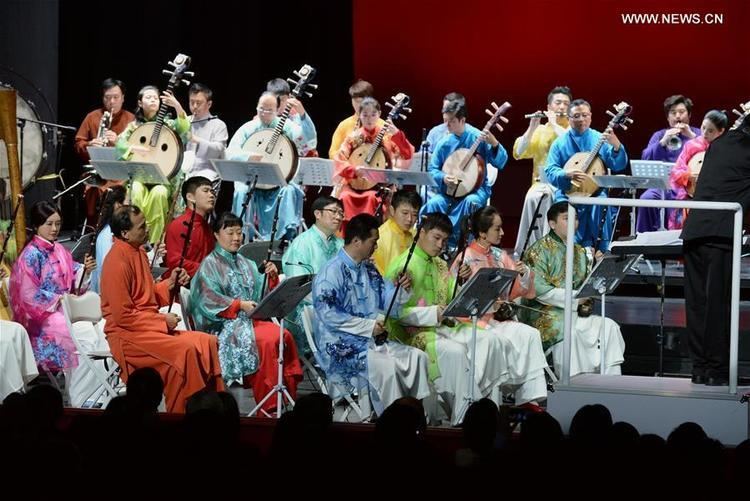Native name 中国中央民族乐团 Principal conductor Liu Sha Active from 1960 | ||
 | ||
Former name China Central Nationalities Orchestra, among many others Similar China Broadcasting Chinese, Hong Kong Chinese Orchestra, Li Huanzhi, Liu Mingyuan, China Philharmonic Orchestra | ||
China national traditional orchestra kicks off nyc tour in lincoln center
The China National Traditional Orchestra (CNTO) (Chinese: 中国中央民族乐团 or 中央民族乐团; also called China National Orchestra) is a 110-piece orchestra of traditional Chinese musical instruments with an accompanying folk choir. Founded in Beijing, China in 1960, the orchestra is a state-level (national) performing arts institution directly administered and endorsed by China's Ministry of Culture (MOC). Its mission is to promote and advance China’s musical heritage. CNTO is part of a cultural exchange program called Image China and the orchestra is managed by the China Arts and Entertainment Group (CAEG).
Contents
- China national traditional orchestra kicks off nyc tour in lincoln center
- Dragon boat racing
- History
- Alternate names
- Criticism
- Notable orchestra members
- Musicians
- Creative team
- Performances
- Highlights
- References
Dragon boat racing
History
The China National Traditional Orchestra was founded by composer and conductor Li Huanzhi (1919-2000), the former chair of the Chinese Musicians' Association. CNTO's current president and producer is musician and ethnomusicologist Xi Qiang, who is a member of the National Committee of the Chinese People’s Political Consultative Conference. In 1993, the orchestra founded Orchestra Asia, together with Ensemble Nipponia of Japan and the South Korean National Orchestra.
In the interest of promoting a larger view of Chinese culture, CNTO became the first Chinese orchestra known for combining music performance with other Chinese art forms, such as painting. Its 2015 concert tour Rediscover Chinese Music, was promoted as "a breathtaking multimedia experience" with storytelling, lighting and sound special effects, multimedia backdrops, and moving scenery.
Alternate names
The China National Traditional Orchestra has been known by several English names over the years, largely due to challenges with Chinese translation. The orchestra's Chinese name is pronounced in Chinese as Zhōngguó Zhōngyāng Mínzú Yuètuán, where Zhōngguó means "China," zhōngyāng means "central," and mínzú yuètuán means "ethnic nationalities" orchestra.
In English-speaking countries, the CNTO has been misidentified as other similarly named Chinese orchestras. The orchestra has also been referred to by different names within the same news article and in the orchestra's own promotional materials.
English variants of the orchestra's name include:
Perhaps owing to its favored relationship with China's Ministry of Culture, orchestra leadership might have continually revised the ensemble's English name to reflect its current importance or social status, differentiate it from countless other Chinese orchestras, and emphasize the CNTO's stated mission of "sharing China's musical heritage with the world." In 2015, the orchestra has been consistently billed and promoted as the China National Traditional Orchestra at the Kennedy Center, Carnegie Hall, and Lincoln Center, as evidenced by venue calendars and ticket sales webpages.
Criticism
The China National Traditional Orchestra has faced its share of criticism – both at home and abroad – in that it did not actually promote authentic Chinese culture in the beginning, but rather, imitated Western culture with its Western-style orchestra model. Historically, traditional Chinese music was performed with soloists or in small ensembles. What's more, the orchestra's concert repertoire has included works by Bach and Strauss, contemporary songs like New York, New York, and non-Chinese patriotic hymns like America the Beautiful. In recent years, the orchestra has focused on the commission and arrangement of more traditional pieces representative of its heritage.
Not to be outdone by Western or popular music trends, the orchestra also collaborates with well-known directors like Wang Chaoge to help inject energy into traditional music performances by "creating innovative shows." The orchestra's performances outside of China appear to be well received, as inferred by sold-out concerts, standing ovations, multiple encores, and media coverage. For example, at the December 2015 Kennedy Center premiere of Rediscover Chinese Music, an audience member was recorded on camera saying "[the show] was moving. It was beautiful." One could assume that the orchestra's efforts to fuse modern stage production values with ethnic melodies has been a successful tactic in attracting new, enthusiastic audiences.
Notable orchestra members
Musicians
Creative team
Performances
The orchestra has performed throughout China and visited dozens of nations on five continents.
